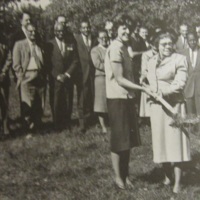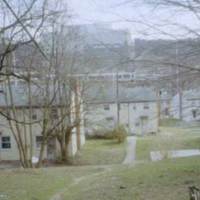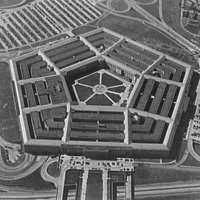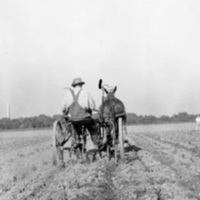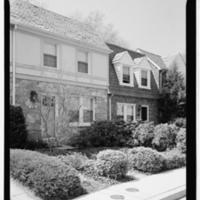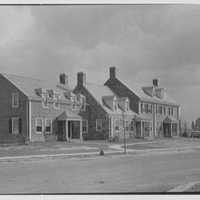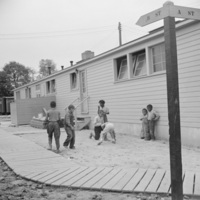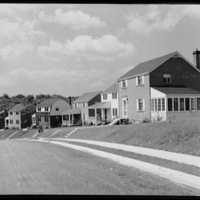Browse Items (79 items total)
In 1946 Arlington's African American community leaders began fundraising for the Veteran's Memorial Branch YMCA. Recreational facilities, including those sponsored by the existing YMCA, were segregated along racial lines at the time. Spearheaded by life-long activist and community resident Edmund Fleet, the Veteran's Memorial Branch YMCA opened in 1949.
It sponsored social and recreational activities for Arlington's black youth. In the 1960s, a pool was added to the facility so Arlington's black youth would finally have a safe place to swim in the county. This photograph shows the groundbreaking for the swimming pool.
It sponsored social and recreational activities for Arlington's black youth. In the 1960s, a pool was added to the facility so Arlington's black youth would finally have a safe place to swim in the county. This photograph shows the groundbreaking for the swimming pool.
Collection: Community Institutions
During World War Two the federal government created six segregated barracks style wartime emergency housing neighborhoods. One of these facilities was the 11-acre Paul Dunbar Homes complex in the Green Valley community, today called Nauck.
Here 86 African American households build a community. Following the war, Arlington officials wanted to tear the neighborhood down. Dunbar residents created the Dunbar Mutual Homes Association which they used to pool their resources, secure a loan, and turn Dunbar Homes into a community dedicated to providing affordable housing. Dunbar Homes was demolished in 2005 to make way for luxury town-homes.
Here 86 African American households build a community. Following the war, Arlington officials wanted to tear the neighborhood down. Dunbar residents created the Dunbar Mutual Homes Association which they used to pool their resources, secure a loan, and turn Dunbar Homes into a community dedicated to providing affordable housing. Dunbar Homes was demolished in 2005 to make way for luxury town-homes.
Collection: Neighborhoods
In 1941 the War Department began building their headquarters, known as the Pentagon, in Arlington. The Pentagon was one of the first federal buildings constructed outside of downtown Washington. The Pentagon's 3.6 million square feet of office space took just over a year to complete at a cost of $75 million.
The unique pentagon shape of the building was chosen so that the building could fit between Arlington Memorial Drive, Arlington Memorial Bridge, National Cemetery, Arlington Ridge Road, and Fort Myer. Though this location was deemed unsuitable for the building, the pentagonal shape remained. The Pentagon's construction led to the destruction of the nearby Queen City African American community.
The unique pentagon shape of the building was chosen so that the building could fit between Arlington Memorial Drive, Arlington Memorial Bridge, National Cemetery, Arlington Ridge Road, and Fort Myer. Though this location was deemed unsuitable for the building, the pentagonal shape remained. The Pentagon's construction led to the destruction of the nearby Queen City African American community.
Collection: Government, Law, & Politics
On land which had once been Arlington Tract Farms, the farming portion of the Freedman’s Village community, the Department of Agriculture created an expansive farm for testing new crops and farming techniques. Known as the Experimental Farm, this facility was created in 1913 between the Butler-Holmes and Johnson’s Hill’s communities. The farm provided Arlingtonians the opportunity to continue to work as farmers long after the region changed from rural to suburban. In 1940 the farm relocated to Maryland to make room for the War Department's building project, which would ultimately use other nearby land upon which to build the Pentagon.
Collection: Government, Law, & Politics
In 1915 and 1929 Arlington County lost land to Alexandria City. Though the county and city provided consistent amenities at the time, including road, water, sewer, and education, the city successfully argued that they were better equipped to handle the rapidly growing environment of suburban Arlington. As a result Arlington lost over 3,000 acres.
In 1930 and 1938 two laws were passed to prevent Arlington from losing more land.
In 1930 and 1938 two laws were passed to prevent Arlington from losing more land.
Collection: Maps
"Architecturally, the rowhouses are distinguished with Colonial Revival detailing in one of three styles: the most prevalent two-story, side entry floor plan like that of 2162 N. Brandywine; the one and one-half story dormered Cape Cod; and the least common, the central-entry plan with a broken cornice/front gable bay above. The houses were advertised as having basements, and two bedrooms and a bathroom on the second floor." - Historic American Building Survey
Collection: Neighborhoods
In 1941 the Defense Homes Corporation (DHC), a subsidiary of Roosevelt's National Housing Agency, purchased 322 acres to develop housing for war-time personnel. Named Fairlington, the community featured 3,449 garden apartments. It was the largest project undertaken by the DHC and was the largest apartment complex in the nation upon its completion.
Designed by architects Kenneth Franzheim and Allen B. Mills, the community features Colonial Revival brick buildings which incorporate shared green space and non-grid cluster patterns in building layout.
After the war Fairlington transitioned from public to private ownership and was successfully converted to a condominium community. Despite a proposal to level the community in favor of high-rise housing in the 1960s, Fairlington remains Arlington's largest selection of moderate-income housing.
Designed by architects Kenneth Franzheim and Allen B. Mills, the community features Colonial Revival brick buildings which incorporate shared green space and non-grid cluster patterns in building layout.
After the war Fairlington transitioned from public to private ownership and was successfully converted to a condominium community. Despite a proposal to level the community in favor of high-rise housing in the 1960s, Fairlington remains Arlington's largest selection of moderate-income housing.
Collection: Neighborhoods
In 1942 the federal government created emergency wartime housing to assist African American residents from Queen City displaced by the construction of the Pentagon. They constructed a trailer camp on mud flats on the outskirts of the Green Valley neighborhood. Entire families squeezed into trailers equipped with stoves for heat and cooking, convertible couch-beds meant to sleep four people, and no running water. The trailer camp was closed shortly after the war.
Collection: Neighborhoods
In 1942 the Office of War Information photographed suburban homes under construction in Arlington. Arlington saw a huge boom in building during the war years as civilian and military federal employees came to work in Washington and the newly constructed Pentagon. This housing boom profoundly changed the make up of Arlington.
Collection: Neighborhoods
This woodcut, featured in Harper's Weekly in 1864, depicts Freedman's Village. A contraband camp established on the grounds of Arlington House, Robert E. Lee's plantation, Freedman's Village was Arlington's first all black community as well as its first successful pre-planned community. Here formerly enslaved men, women, and children learned trades, attended school, established churches, and create a thriving African American community. When the Village was formally closed by the federal government in 1900 it lead to the establishment of many other black communities in Arlington through the Freedman's Village diaspora.
Collection: Neighborhoods
